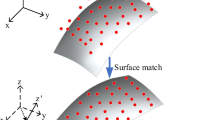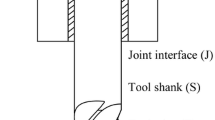Abstract
In this paper, a method is proposed to optimize the fixture layout in the peripheral milling of a low-rigidity workpiece. Because the locators on the secondary locating surface directly influence the deformation of the workpiece in peripheral milling, this paper deals with the optimization of the number and positions of the locators on the secondary locating surface. The method proposed in this paper includes two stages. In the first stage, the initial number and positions of the locators are determined by adding the locators at the position with the maximum deformation. In the second stage, the number and positions of the locators are optimized. Using the method proposed in this paper, the number of locators is reduced, while the machining accuracy of the workpiece is retained.
Similar content being viewed by others
References
Menassa RJ, DeVries WR (1991) Optimization methods applied to selecting support positions in fixture design. Trans ASME J Eng Ind 113:412–418
Cai WJ, Hu SJ, Yuan JX (1996) Deformable sheet metal fixturing: principles, algorithms and simulations. Trans ASME J Manuf Sci Eng 118(3):318–324
Roy U, Liao JM (1999) Geometric reasoning for re-allocation of supporting and clamping positions in the automated fixture design system. IIE Trans 31(4):313–322
Vallapuzha S, DeMeter EC, Choudhuri S, Khetan RP (2002) An investigation into the use of spatial coordinates for the genetic algorithm based solution of the fixture layout optimization problem. Int J Mach Tools Manuf 42(2):265–275
Kulankara K, Satyanarayana S, Melkote SN (2002) Iterative fixture layout and clamping force optimization using the genetic algorithm. Trans ASME J Manuf Sci Eng 124(1):119–125
Tan EYT, Kumar AS, Fuh JYH, Nee AYC (2004) Modeling, analysis, and verification of optimal fixturing design. IEEE Trans Automat Sci Eng 1(2):121–132
Rearick MR, Hu SJ, Wu SM (1993) Optimal fixture design for deformable sheet metal workpieces. Trans NAMRI/SME 21:407–412
Liao YG (2003) A genetic algorithm-based fixture locating positions and clamping schemes optimization. Proc Inst Mech Eng B J Eng Manuf 217(8):1075–1083
Li B, Shiu BW, Lau KJ (2001) Principle and simulation of fixture configuration design for sheet metal assembly with laser welding. Part 1: finite-element modelling and a prediction and correction method. Int J Adv Manuf Technol 18(4):266–275
Li B, Shiu BW (2001). Principle and simulation of fixture configuration design for sheet metal assembly with laser welding. Part 2: optimal configuration design with the genetic algorithm. Int J Adv Manuf Technol 18(4):276–284
Sutherland JW, DeVor RE (1986) An improved method for cutting force and surface error prediction in flexible end milling systems. Trans ASME J Eng Ind 108(4):269–279
Zheng L, Liang SY, Melkote SN (1998) Angle domain analytical model for end milling forces. Trans ASME J Manuf Sci Eng 120(2):252–258
Zheng HQ, Li XP, Wong YS, Nee AYC (1999) Theoretical modelling and simulation of cutting forces in face milling with cutter runout. Int J Mach Tools Manuf 39(12):2003–2018
Liu XW, Cheng K, Webb D, Luo XC (2002) Improved dynamic cutting force model in peripheral milling. Part I: theoretical model and simulation. Int J Adv Manuf Technol 20(9):631–638
Budak E, Altintas Y (1995) Modeling and avoidance of static form errors in peripheral milling of plates. Int J Mach Tools Manuf 35(3):459–476
Tsai JS, Liao CL (1999) Finite-element modeling of static surface errors in the peripheral milling of thin-walled workpieces. J Mater Process Technol 94(2–3):235–246
Ratchev S, Huang W, Liu S, Becker AA (2004) Modelling and simulation environment for machining of low-rigidity components. J Mater Process Technol 153:67–73
Liu SG, Zheng L, Zhang ZH, Wen DH (2006) Optimal fixture design in peripheral milling of thin-walled workpiece. Int J Adv Manuf Technol 28(7–8):653–658
Acknowledgment
The authors would like to acknowledge the financial support from the Rolls-Royce Company for this investigation.
Author information
Authors and Affiliations
Corresponding author
Rights and permissions
About this article
Cite this article
Liu, SG., Zheng, L., Zhang, ZH. et al. Optimization of the number and positions of fixture locators in the peripheral milling of a low-rigidity workpiece. Int J Adv Manuf Technol 33, 668–676 (2007). https://doi.org/10.1007/s00170-006-0507-5
Received:
Accepted:
Published:
Issue Date:
DOI: https://doi.org/10.1007/s00170-006-0507-5




